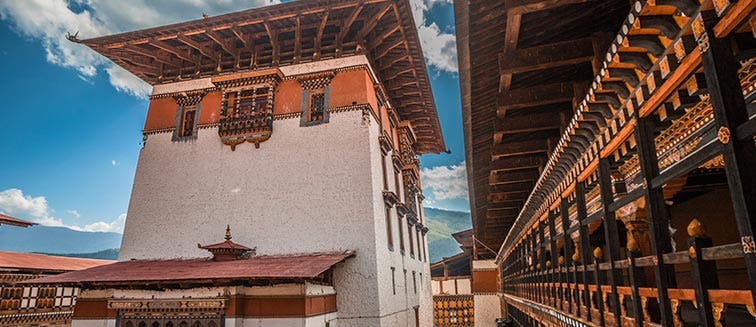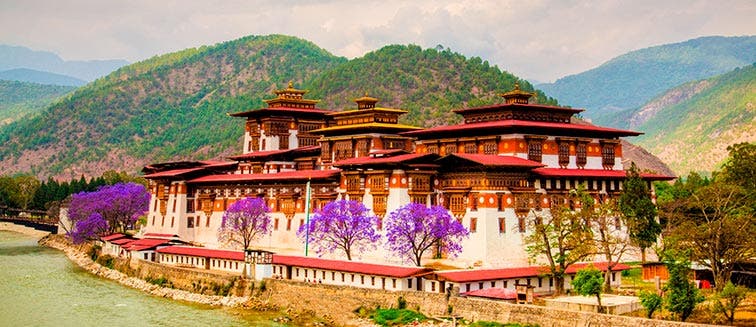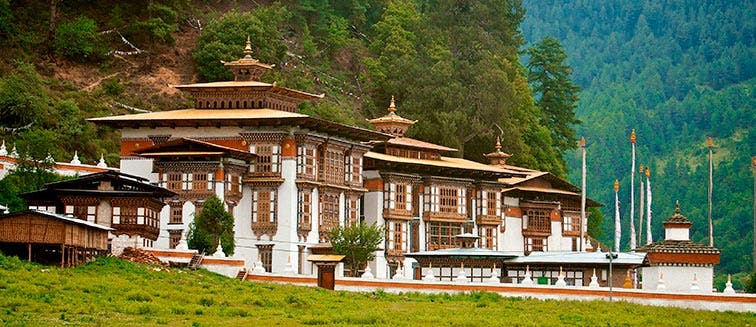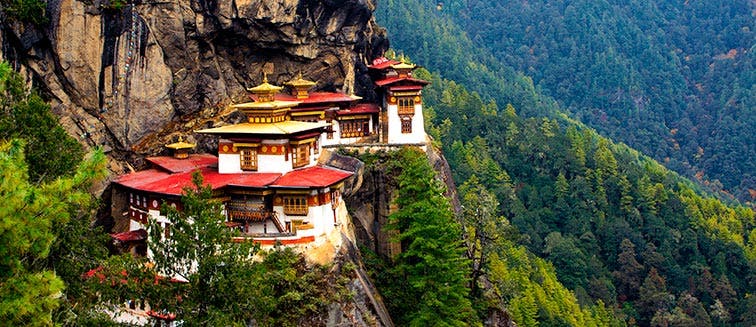At the eastern end of the Himalayas lies a small country named Bhutan. Known as the "Land of the Thunder Dragon", believing that the violent storms that occur in the highest mountains in the world came from this dreaded dragon, this hidden kingdom is one of the most exclusive destinations on the planet and a unique place to enjoy a fascinating package tour holiday.
It borders the two most populated countries in the world, on the north with China and on the south with India. It is landlocked and has a small area of 40,994 km², divided into 10 provinces in which its 800,000 inhabitants live. The highest peak is Gankhar Puensum at 7540 m, whose summit is famed for having never been climbed. All the rivers are linked to the Brahmaputra basin, the Drangme Chhu being the most important. None of them is navigable and they are fed by glaciers and monsoon rains.The climate varies from north to south and from east to west. In the areas near the Himalayas, the summers are cool and the winters are glacial; in the valleys, the temperature is temperate with hot summers and cold winters and the south is subtropical, with great rainfall that decreases at higher altitudes and to the east.The current monarch, Jigme Khesar Namgyal Wangchuck, is the fifth of a dynasty that was established in December 1907 and is called the "king of the dragon". After centuries of absolute monarchy of a theocratic nature, Bhutan's model of government became a parliamentary monarchy and the country held its first democratic elections in 2008. The urban centers are impeccably integrated into the Bhutan landscape. Everything appears unchanged despite the passage of time. One of the most emblematic and important buildings of the kingdom are the dzongs, a mixture between a fortress and a Buddhist temple with a certain oriental medieval air, which is scattered throughout the territory. They house the monastic community of the region and the administration offices and serve as both civil and religious building at the same time. Its imposing architecture shows a robust and solid aesthetic in the defensive towers and high stone walls whitewashed and decorated in its upper part with colored borders. Doors, balconies, and windows are framed with ornaments and beams of exquisitely carved and colored wood. Its courtyards are adorned with colorful fabrics during the celebration of the tseshus or religious festivals, in which all the inhabitants of the region participate.The temples are distinguished from the houses by a wide red band that decorates the upper part of its facade and the prayer wheels of the lower part. A government decree has forced the villagers to respect the style of the traditional Bhutanese house, so cities and towns lack modern buildings. All architectural designs respect the aesthetics of the country. In the villages, the houses are large and made of wood or bamboo. The first floor is intended for animals, the second as storage and kitchen and the third, is where the family resides. There is always a room for a family altar or chosum. Numerous walls of rural facades are adorned with paintings of sacred animals to attract good luck and ward off evil spirits. Help between neighbors is the basis of these communities.There is a dress code in Bhutan, another element to the traditionalism of the country. The typical costume is the daily attire worn during work hours by everyone from tour guides, farmers, masons, teachers, students or officials among others. They wear a Kira, a long dress to the ankles and silk shirt of cheerful colors and a gho, a kind of smooth or checkered gown, tied at the waist, with large white cuffs that complement their knee-high socks. To enter the dzongs, men have to put a shawl over their shoulders around their chest as a sign of respect. Its color determines the wearers status: orange for the officers, yellow for the king and beige for the people in general.Archery is the national sport and attending and participating in competitions are one of the leisure activities preferred by the locals.Bhutan is one of the most biologically diverse countries in the world: elephants, rhinoceroses, snow leopards, Bengal tigers, red pandas, golden langurs, black bears of the Himalayas, ravens, which are considered the national animal, and up to 670 species of birds such as the endemic black-necked crane, can be found in the country. The vegetation is represented by extensive and shady forests of conifers, pines, oaks, rhododendrons and junipers, meadows of magnolias, orchids and blue poppies and up to 300 species of medicinal plants. The ten national parks that exist throughout the country guarantee the preservation of their wildlife.
Bhutan happiness index
In 1972 the king created the concept of "Bhutan's Gross National Happiness Index" replacing the concept of the gross domestic product, a value measure used by the other economic models of the world.This curious concept, invented according to the Buddhist philosophy, aims to ensure the welfare of the population by guaranteeing social rights and respect for the environment and natural resources, rather than focusing on material goods. Its four basic pillars are sustainable and egalitarian socio-economic development, the protection and promotion of cultural values, the conservation of the environment and the establishment of good governance. It is not surprising that Bhutan is thought to be one of the most peaceful and happy societies in the world.Bhutan has not taken on industrialization and globalization as the rest of the world have. Until recently the borders were closed, and although it has begun to open itself to the world in recent years, it remains shy, preserving its privacy to the maximum. In 1975 the first hotel was built to accommodate the guests for the coronation of the king. In 1999 came the first car, the first television, and the internet. It lacks factories and buys all manufactured products, fuels and technologies from Indian neighbors. There are no fast food restaurants and there are no advertising signs or international brands. No plastic bags are used. There are no zoos and it is prohibited to cage animals and since 2004, the commercialization and consumption of tobacco in the street and public places was prohibited.It also holds a number of world records. 72% of the country is covered in forests, so it is the only country in the world that is carbon negative; it is the first one with a hundred percent ecological agriculture, which ensures a healthy and high nutritional value and the second most smoke-free country.
Bhutan's economy
Bhutan's economy is based on the agriculture of barley and rice and subsistence livestock. Tourism is the second source of national wealth, but despite this, Bhutanese want to preserve their natural and cultural heritage. For this, the government has regulated the entry of tourists charging a daily rate, so they can not travel freely, but only through one of the agencies with official permission, which are responsible for organizing trips to Bhutan with all necessary concepts included in the price: visa, food, accommodation, transportation, guide and entry to the places visited. The objective is to promote quality tourism focused on those travelers who wish to know the country specifically, always putting respect for nature and traditions first, so as to produce a low environmental, economic and social impact.There are many reasons to take a tour of Bhutan and several types of trips that can be carried out either alone, with friends, as a family or as a couple: hiking, bird watching, meditation, cultural or a mixture of all of them.75% of the population is Buddhist and the official religion is the Tantric form of Mahayana Buddhism, originally from neighboring Tibet. There are meditation and yoga centers in the temples and monasteries, and hotels also have facilities for this purpose available to their guests. Both the landscapes, cities and rural areas of Bhutan look like the setting of a film in which all the details have been taken care of to create an impeccable staging where there is no element that destroys the sought after authenticity. The interpreters are perfectly integrated with their clothing and wander in harmony through the so-called country of happiness that is anchored to their traditions, almost isolated and trying to remain inaccessible to Western influence. This makes Bhutan a very unique place to enjoy a holiday.
Dusting this remote hidden country of the Himalayas from the map and choosing to travel to Bhutan is an excellent decision. For people who want a unique experience where they can slow down and put the level of stress to zero, forget the asphalt and get back together with nature, experience an exquisite treatment, admire unique architecture, hear how the wind rustles the prayer flags, breathe fresh air, find inner peace, throw your prayers to the mountains, feel the tranquility and the most absolute silence, sink your gaze on the horizon between steep peaks, forests, rivers, bridges and valleys, listen to the deep sound of the mantras in the monasteries and see the happiness in the faces of the people, then, the last Shangri-La will be waiting for you, hidden among the unexplored and snow-capped mountains.





